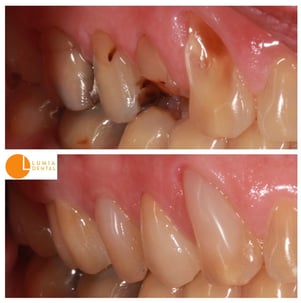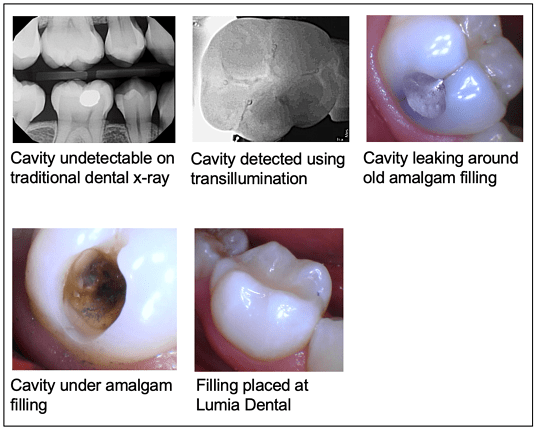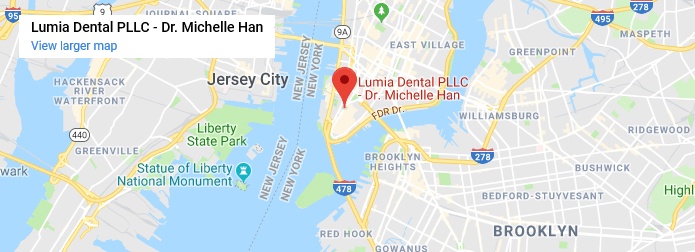 Cavities and cracks result in destruction of tooth structure and necessitate a dental restoration, which could be as minimal as a filling or as comprehensive as a crown.
Cavities and cracks result in destruction of tooth structure and necessitate a dental restoration, which could be as minimal as a filling or as comprehensive as a crown.
What is a cavity?
Teeth are hard, calcified tissue. If exposed to acids, it will erode, weaken, and wear away. Once it penetrates the outer layer of the tooth (=“enamel”), it will enter the core of the tooth (=“dentin”) and keep spreading until it reaches the inner core, which houses the soft tissues (nerves and blood vessels) of the tooth (=“pulp”). If this erosion is not stopped and is in an area that is difficult to keep clean (e.g. between teeth, or in the nooks and crannies of the biting surface of a tooth), it will keep eroding and spreading.
We call this acid erosion a ”cavity”. It makes little holes in the tooth and stains with time, because it is weakened, porous tooth structure.
Traditionally, cavities would form from the bad bacteria in our mouth (just as we house bacteria in our gut!) eating our foods – they especially love the sugars, because it is sticky (perfect for making a home for them!) and is their primary food form – and producing acid as a by-product. This acid sits on our teeth, festers, and forms cavities.
Nowadays, teeth get cavities from consuming the widely available the delicious carbonated beverages, sticky candies and snacks, and acidic beverages.
How can I prevent or slow down a cavity?
Keeping it clean. Brushing gentle and thoroughly keeps the outer layer of the teeth cleaner. Flossing correctly prevents cavities from forming between the teeth, because it’s not physically possible to actually fit the toothbrush between the teeth.
Avoiding carbonated beverages, sticky candies and snacks, and acidic beverages will also help prevent constant weakening and erosion of enamel. Once that enamel is worn away, it’s gone.
The fluoride in most toothpastes and dental rinses, in most municipal water, and even in some bottled water, sticks to our teeth and calcifies our enamel, fortifying it even stronger than it was before. That’s why we brush our teeth using fluoridated toothpaste – to coat our teeth with a medicine that strengthens our teeth.
That’s why preventive dental visits – checkups and cleanings – are so important. We need to catch problems before they get worse and make sure you’re on track for healthy gums and teeth.
Why is my dentist “watching” a cavity?
The enamel (outer layer of the tooth) is the hardest part of the body. It is very strong and difficult to penetrate. If a cavity appears to be confined only to this strong, outer layer, a dentist may decide to only monitor it, because it may not grow and get worse, if the patient maintains it well. Your dentist and your dental hygienist will educate you to ensure you’re maintaining it well. But we have to keep checking every 6 months. Once the small cavity appears to have penetrated through the thickness of the enamel, we would need to treat it before it starts to spread much more quickly in the softer inner dentin layer.
Why can’t we keep watching it? It doesn’t bother me!
Once the cavity has penetrated through the enamel and has reached the inner dentin layer, it will spread much more quickly. We are trying to prevent more extensive dental treatment. If we catch it early enough and has not spread too much, we can place a filling and preserve the remaining healthy tooth structure. Tooth structure does not grow back! Once it has become damaged, it is gone. The point of modern dentistry is to prevent problems and rebuild/restore what tooth structure has been lost. We do not want to wait until you need more extensive dental treatment. Cavities can sometimes grow so deep that a tooth cannot be saved!
But it doesn’t hurt – how can I have a cavity?
Patients often wonder why they are told that they have a cavity or crack in their tooth even though nothing hurts or bothers them. They’re right! It shouldn’t hurt. It will only hurt if the nerves inside the tooth are bothered by the cavity or crack. In other words, if a cavity or fracture is left for too long, it can start to become sensitive, or even painful. This often necessitates a root canal treatment. Make sure you get your checkups and cleanings regularly to minimize the amount of dental treatment you may need.
Why did my tooth break? Do I have weak teeth?
Nothing is unbreakable. You do not have weak teeth. Teeth are considered “permanent”, but nothing is permanent, and nothing is unbreakable. With the consistent tons of force we apply on our teeth everyday from chewing our foods, it is typical to have some mild wear and tear over the years. Teeth can also chip or break. This can sometimes indicate a problem, such a cavity that has weakened the tooth and given way. It can also mean that you may be grinding or clenching your teeth – adding more biting force than what your teeth were designed to withstand. Dentists are trained to use specialized dental materials to rebuild and restore teeth that are damaged from fracture.
Your Lumia Dental providers are highly experienced in modern, conservative dentistry.
They will choose the latest materials and technology available to restore your teeth and smile.
Dental Fillings: Tooth-colored fillings are used to repair minor damage and cavities.
Dental Inlays and Onlays: When the cavity or damage becomes more extensive, placing a filling can result in a bigger problem, such as post-operative sensitivity or fracture. Inlays and onlays can rebuild tooth structure while being more conservative than a crown or cap.
Dental Crowns or Caps: If a tooth is too badly decayed or damaged, a crown will protect the tooth best.
Dental Bridges: When a dental implant is not possible to replace a missing tooth, adjacent teeth can be used to “bridge the gap” and replace the missing tooth.

Check out our Smile Gallery for examples of our General Restorative Dentistry cases.
.png?width=200&name=lumia-dental-logo-text-500(1).png)


